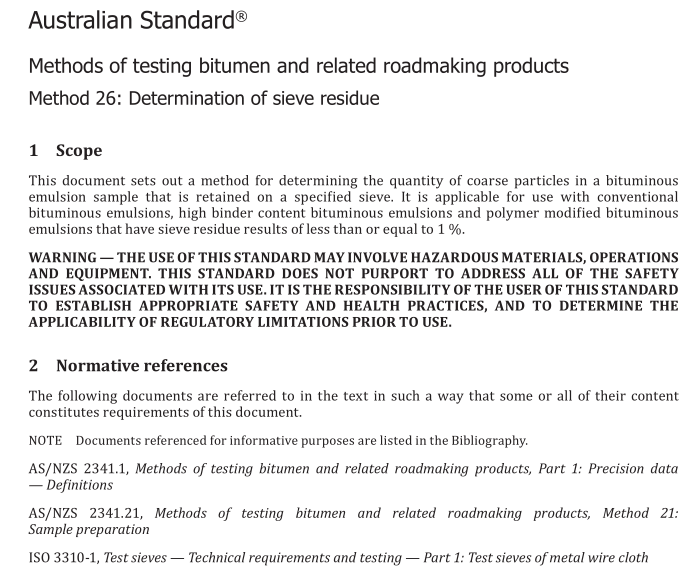AS 2341.26 pdf download – Methods of testing bitumen and related roadmaking products Method 26: Determination of sieve residue

AS 2341.26 pdf download – Methods of testing bitumen and related roadmaking products Method 26: Determination of sieve residue
6 Preparation of sample Samples shall be obtained and prepared for testing in accordance with AS/NZS 2341.21. The sample shall be cooled to room temperature before testing.
7 Procedure Either the 150 μm or the 710 μm sieve may be used for the test, depending on specified requirements. The procedures for the 150 μm sieve and 710 μm sieve are as follows:
(a) Place the sieve on the sieve tray and dry in the oven at 105 °C to 110 °C. Once dried, remove from the oven and allow to cool to room temperature. When cooled, place the sieve together with sieve tray on the balance. Weigh the sieve together with the sieve tray to the nearest 0.001 g (m 1 ).
(b) Rinse the container with the appropriate surfactant solution using the wash bottle. Place the container on the balance and tare the balance to zero. If the 150 μm sieve is being used, pour approximately 100 g of emulsion sample into the container. If the 710 μm sieve is being used, pour approximately 200 g of emulsion sample into the container. Record the mass of emulsion sample added to the container to the nearest 0.001 g (m 2 ).
NOTE 1 Caution is required when performing the test to ensure that the sample does not include a surface skin which has formed due to bituminous emulsion cooling. If a surface skin is present on the sample due to cooling, this should be removed prior to pouring the bituminous emulsion sample into the container. NOTE 2 High binder content bituminous emulsions may be too viscous to readily pass through the sieve and may need to be diluted with up to 50 % w/w surfactant solution to reduce emulsion viscosity and facilitate rapid flow through the sieve. If the bituminous emulsion is diluted prior to adding to the container, then the mass of sample added to the container should be adjusted to account for the dilution of the emulsion sample. The value of m 2 should correspond to the mass of the undiluted emulsion sample.
(c) Place the sieve over the glass beaker and rinse it with the surfactant solution using the wash bottle. Pour the emulsion rapidly through the sieve. Rinse the container using the surfactant solution in the wash bottle to remove any remaining emulsion in the container. Pour the rinsings from the container through the sieve.
(d) Rinse the sieve and its contents with the surfactant solution from the wash bottle until no liquid bituminous emulsion remains on the sieve. After all of the liquid bituminous emulsion has passed through the sieve, rinse the sieve with water to remove any remaining surfactant solution. Examine the sieve for any retained material.
(e) Place the sieve on the sieve tray and dry the sieve, sieve tray and residue in the oven at 105 °C to 110 °C for 1 h. Remove the sieve, sieve tray and residue from the oven and allow to cool to room temperature. Weigh the sieve together with the sieve tray and residue to the nearest 0.001 g (m 3 ).









